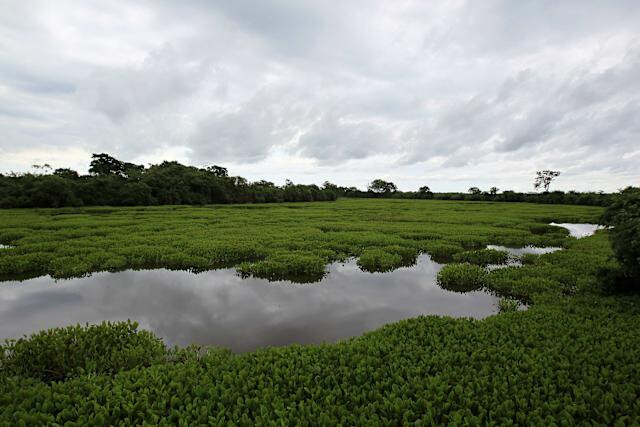
Brazil lost 400,000 hectares of water surface in 2024, an area equivalent to more than twice the size of the city of São Paulo, according to the update of the MapBiomas Agua historical series, published this Friday (21). The country's territory covered by water bodies and reservoirs reached 17.9 million hectares, representing a 2% decrease compared to the 18.3 million hectares recorded in 2023.
According to the new collection of maps and data on national territory coverage by water surface, the trajectory of decrease in this area has intensified in the last decade, in which eight of the driest years of the historical series initiated in 1985 were recorded. In this period, only in 2022 was there a recovery of the water surface, reaching 18.8 million hectares.
According to researcher Juliano Schirmbeck, technical coordinator of MapBiomas Agua, Brazil is drier due to the dynamics of land occupation and use associated with extreme climatic events.
"These data serve as an alert about the need for adaptive water management strategies and public policies that reverse this trend," he states.
In 2024, the Amazon registered 10.9 million hectares of water surface, representing 61% of the total in Brazil. The Atlantic Forest registered 2.2 million hectares or 13% of the total, the Pampa 1.8 million hectares or 10% of the total, the Cerrado 1.6 million hectares or 9% of the total, and the Caatinga 981,000 hectares or 5% of the total.
The Pantanal, the smallest of the six Brazilian biomes, registered only 366,000 hectares of water surface in 2024, representing just 2% of the country's total. However, this biome had a 4.1% reduction compared to the previous year and was the most affected by the reduction since 1985, with a 61% loss of its water surface over these years.
"Since the last flood in 2018, the biome has faced an increase in drought periods, and in 2024, the extreme drought increased the incidence and spread of fires," explains researcher Eduardo Rosa, from the MapBiomas Agua team.
The extreme drought that affected the Amazon in 2024 also impacted its water surfaces, causing a reduction of 1.1 million hectares compared to 2023 and 4.5 million hectares in relation to 2022.
Last year, almost two-thirds (63%) of the 47 hydrographic sub-basins registered a loss of water surface compared to the historical average. Sub-basins of the Rio Negro have already lost more than 50,000 hectares in the historical average.
"There have been two consecutive years of extreme droughts in the Amazon, and in 2024 the drought arrived earlier, affecting basins that were not strongly impacted in 2023, such as the Tapajós," highlights MapBiomas researcher Carlos Souza Jr.
Compared to 2023, the Pampa biome remained practically stable, with an increase of approximately 100,000 hectares of area covered by water, still remaining 0.3% below its historical average.
According to Juliano Schirmbeck, this is due to climatic extremes, which are indicated as the main consequence of changes caused by global warming.
"The Pampa had a start of the year with droughts, with March being the driest month of the year. In April and May, an extreme flood occurred, reaching the largest monthly surface of the 40 years of the historical series," he explains.
Throughout last year, the Caatinga, the Cerrado, and the Atlantic Forest remained above the historical average, with the Caatinga standing out, which ended the year with six thousand hectares more than in 2023 and the largest area covered by water in the last 10 years.
According to researcher Diêgo Costa, from the Caatinga team of MapBiomas, this result indicates the consolidation of a flood cycle initiated in 2018, but it is necessary to be alert. "Despite this favorable scenario, areas with recurrent droughts persist, especially along the São Francisco basin and in the Seridó Nordestino region—territories particularly vulnerable to desertification," he emphasizes.
A phenomenon observed in the Cerrado biome was the substitution of natural water bodies, such as rivers and lakes, by artificial water surfaces such as dams and reservoirs. Throughout the 40 years of the historical series, the regions where the biome occurs have seen their natural water surfaces reduce from 62% to 40% in 2024. Meanwhile, artificial surfaces increased from 37% to 60% last year. As a result, the areas occupied by water in the biome remained unchanged in the last year.
In general, in Brazil, there has been a historical growth of artificial water surface, with an increase of 1.5 million hectares throughout the historical series. Among the biomes that most concentrate reservoirs and dams are the Atlantic Forest (33%) and the Cerrado (24%).
Although they still represent 77% of the area covered by water in the country, natural water bodies have decreased by 15% in these 40 years.
According to Schirmbeck, the increase in water surface in the Cerrado, Caatinga, and Atlantic Forest is due to the growth of water stored in hydroelectric plants and other types of reservoirs.
[Copyright (c) Global Economic Times. All Rights Reserved.]






























